- Ask a related questionWhat is a related question?A related question is a question created from another question. When the related question is created, it will be automatically linked to the original question.
This thread has been locked.
If you have a related question, please click the "Ask a related question" button in the top right corner. The newly created question will be automatically linked to this question.
Tool/software:
Greetings, professionals and forum visitors. I would like to ask your help with LM5145 converter. In my project, converter being powered by 48V Li-Ion battery (input voltage range 41-55V), and should step it down to 24V with top current of 6A. With no or light load everything works just fine, but after 4A it shuts down, or outputs only half of the required voltage (you may see on video). Increasing Rilim or changing LM5145 itself made no results, also there is no overheating in converter chip, mosfets or inductor. I'll attach plots from HO, LO and SW down below, as well as schematics and PCB. Where should I suppose to look to find a problem? Thank you in advance.
Load test #1 (Input 56V):
Load test #2 (48V input):
HO with no load:

LO with no load:

SW with no load:

Signal width on SW under load of 3A starts chaotically change, not sure is it ok or not (as well as signals on LO and HO, acts the same):
Schematics:
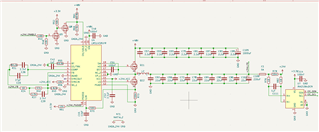
PCB top layer:
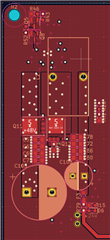
PCB inner 1 layer:
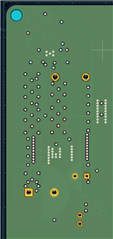
PCB inner 2 layer:
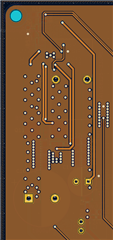
PCB bottom layer:
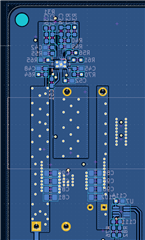
LM5145 Quick start calculator with actual values
Hi Ihor,
Looks like you're unstable. Note the 22uF ceramics must be derated for voltage (24VDC) - each cap is probably only a few uF of capacitance. Also, entering the correct ESR value in the quickstart is critical. Here is a file to calculate the effective Cout and ESR given the ceramic and electrolytic output cap combo. Then go ahead and recompensate.
5706.Parallel Capacitors Zct LM5145.xls
Make sure the 220uF is a polymer electrolytic, not aluminum. Al caps have high ESR that increases dramatically at cold, making compensation almost impossible.
-Tim
PS: we have converters (with integrated FETs) that can do 6A...check out the LM70860 80V/6A converter.
Hi Tim, thank you for valuable advice. My output ceramics was rated for 25V, and electrolytic for 35V, I changed ceramics to 16 x 10uF/50V, electrolytic to 220uF/63V (cannot find polymer caps locally, will order and wait for delivery), eyeballed derating by dividing total capacitance in half (sorry for that, your excel derating tool amazing, but I haven't values of ESR for this particular caps) and calculated new compensation network values.
Cc1 was 2.7nF, now 2.7nF;
Cc2 was 27pF, now 39pF;
Rc1 was 56.2k, now 39.2k;
Rc2 was 1.5k, now 102R;
Cc3 was 2.7nF, now 1.8nF;
I soldered the closest possible values from what I have, and almost nothing changes.
However, I noticed that converter handles 6A while VIN 44V or lower, 5A up to 48V and 4A up to 55V. Why lower input voltage works better, is it also evidence of wrong compensation, or it's something else? I would appreciate any help with this.
P.S. pwm signal on HO, LO and SW without load after recalculating COMP network began to change width chaotically like on video under load (before it signal width was more stable)
don't know, is it related or not, changed Rt resistor to increase Fsw from 200kHz to 300kHz, just for test. Controller still shuts down while in increasing load from 4A to 5A, BUT if I set 6A and just go on or off load, it withstands it solid. So, maybe noname inductor from LCSC saturates much more earlier, than it should be... is it possible, or it's just coincidence? And if it holds 6A, why it still goes off after 4A?
Hi Ihor,
I would remove the output electrolytic (as its ESR is too high) and compensate with just the ceramics. Check the Murata site for derating: https://ds.murata.co.jp/simsurfing/mlcc.html?lcid=en-us&jis=false
A 10uF/50V/X7R/1210 is 5.8uF at room temp, 24VDC and a bit lower at hot. Maybe use 5uF per cap as the effective value in the quickstart.
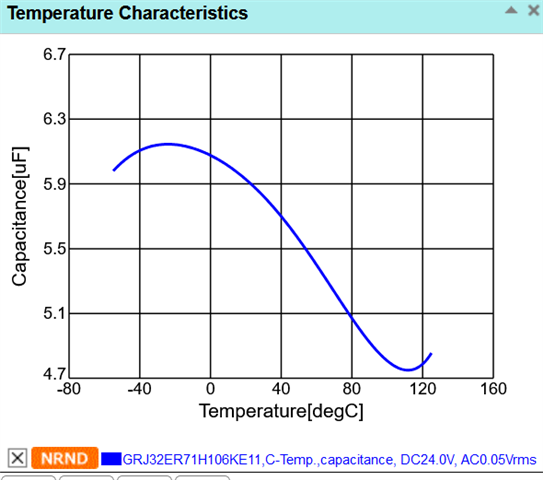
Hi Timothy, thanks for your advices! Just removed electrolytic, recalculated comp network and went back to Fsw=200kHz. Signals on SW, HO and LO rock-solid from 0 to 4A, but still goes to shutdown while increasing from 4A to 5A. If I set 5A or 6A on electronic load, and turn it on, converter works, but signals on HO, LO and SW starts wiggling back and forth. So, is it now just a question of precise compensation (like, I needed 68pF, and just used two 33pF in parallel), or it maybe something else?
Also, while it goes to protection mode, signal on SW looks like this:

It's quite unusual for it to be stable at light load and not at full load (typically light load is slightly worse, as the Q of the LC poles is higher).
Send on the latest quickstart file.
This seems like an overcurrent issue. Is the current limit set correctly based on 10mΩ sense resistance? 590Ω will setup a valley current limit of 5.9A (so the DC output current will be half the ripple above this). Try increase the current limit setpoint resistor and see if more current is possible.
Final quickstart file:
I've played around few parameters:
1. Crossover frequency, converter became more unstable on higher one (30 kHz), so I went down to 20 kHz;
2. increased current limit to Iout*2, by setting Rilim to 1.2kOhm;
3. noted that 1mOhm and 0.1mOhm of output ESR making significant difference in Rc2, so changed it accordingly.
And in the end of the day it worked without any problems, output current rising and falling without shutting down, control signals stable (as for my opinion). So, I think that's it, and I hope it's not an coincidence ;)
So, I want to thank you so much for your valuable debugging advices, especially because now I'm thinking that all of my other synchronous converters may be suffering from similar design mistakes (because of similar symptoms, like unexpected shutdown).
P.S. Is it worth it to switch from CCM to DCM to decrease losses on light loads, or converter will suffer on max output current?